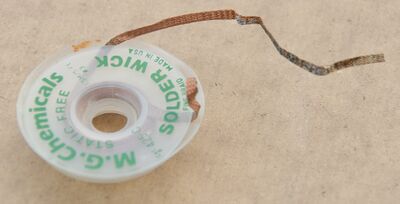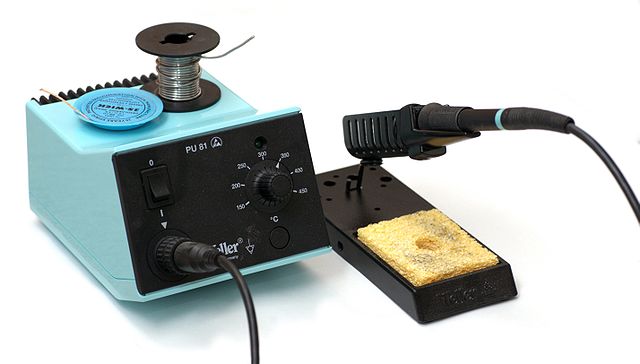Soldering: Tools
Summary: Be sure to use a properly sized iron for the job. Additionally, there are many tools available to help with soldering, such as helping hands, iron stands, and more.
Tools and Supplies Required for Electrical and Model Work
- Properly sized soldering iron for the job (see above)
- Solder sucker (for desoldering)
- Unsoldering braid (for desoldering)
- Heat sinks (metal clamps) to draw heat away from heat sensitive components
- Hemostats
- Alligator clips
- Vinyl electrical tape
Wire-Cage Soldering Iron Stand
The stand holds the iron when not in use, and protects you from accidentally being burned. Stands including a sponge or similar device for cleaning the tip of excess solder or dross are also available. A cotton rag or paper towels also work to clean the tip. If you use the sponge, it should be moistened with distilled water. Too much water cools the tip during cleaning. Excessive cleaning with a damp sponge hastens the demise of your tips.
Interchangeable Soldering Iron Tips
For more information on tips and their care, see the Irons article.
Soldering iron tips are usually made of copper, which is plated with base metals (such as iron) and chrome. The tip must be "tinned" or "wetted" before use to encourage heat transfer to the junction.
Never file or sand a soldering iron tip, this removes the iron plating exposing the copper beneath causing it to oxidize, preventing it from transferring heat properly to the work being soldered. Exposing the underlying copper allows the solder to alloy with the copper. The copper is eroded by the alloying process, making the tip useless as you cannot get a good contact surface with the work. For ease of tinning, consider using a product such as the Plato Tip-Tin paste, which you simply dip the tip of the soldering iron into.
Conical or Pencil Tip
Useful for soldering in tight areas, such as leads onto a PCB. Not very good for large items. As the name suggests, it looks like the sharp end of the pencil. There are different styles available, some are short and fat where others are long and thin.
Chisel Tip
Larger tips have more thermal mass, so choose accordingly. Too big is not better. A chisel tip looks like its namesake: The business end of a chisel. Chisel tips are useful for track work, etc. Their larger thermal mass takes longer to heat, but also has more energy to transfer to the work. When using with track to solder feeders or construct turnouts, it will allow you to complete the task quickly. A hot iron with a chisel tip that maintains the temperature will do less damage than one with a small tip which takes longer to complete the task.
Wire Strippers
The one on the left is an inexpensive one, but it can be a little difficult. The one of the right is a heavy-duty tool, capable of handling 22 to 8 AWG wires.]] Wire strippers are a quick and easy way to remove insulation from the wires prior to soldering. They are better than using a knife (and you should not use your teeth!) as knives and other more brutal techniques can nick the conductors, leading to failure later. Strippers work by cutting the insulation, then pulling it toward the end of the wire. Simple tools like those sold with sets of crimp on terminals just cut the insulation, then you have to pull the tool toward the end of the wire. Better strippers, like those shown in the picture, will strip the wire when you squeeze the handles.
Hand Tools
Hand held tools such are tweezers, pliers and other tools are useful for holding things together when soldering. Small clamps and heat sinks are needed to prevent heat traveling on rails, and they can also hold feeder wires in place. Wrapping an elastic band around the handles of a pair of pliers can create a small clamp quickly.
"Helping Hands" are also useful to hold things in position when soldering.
A heat resistant work surface is also useful to prevent burns on the bench.
Accessories
There are many accessories for soldering. Any well stocked electronics supply shop will have an assortment, such as tip cleaners made of brass turnings, flux applicators, brushes for application or removal of flux, etc. They will also stock soldering irons, an assortment of tips, replacement parts, and chemicals such as fluxes and flux removers. Another useful item is solder wick, which is used to wick away solder from the joint during an unsoldering operation.


